Bi-LSTM-Augmented Deep Neural Network for Multi-Gbps VCSEL-Based Visible Light Communication Link
Abstract
:1. Introduction
2. Characteristics of VCSEL
2.1. Principle of VCSEL
2.2. Experimental Analysis of VCSELs’ Characteristics
3. Long Short-Term Memory Network
4. Proof of Concept Demonstration
4.1. Experimental Set-Up
4.2. Communication Test Result
5. Discussion and Conclusions
Author Contributions
Funding
Institutional Review Board Statement
Informed Consent Statement
Data Availability Statement
Acknowledgments
Conflicts of Interest
Abbreviation
| AC | alternating current |
| AI | artificial intelligent |
| AML | adversarial machine learning |
| BER | bit-error-rate |
| Bi-LSTM | bidirectional long short-term memory |
| DBR | distributed Bragg reflector |
| DC | direct current |
| DCO-OFDM | direct current-biased orthogonal frequency division multiplexing |
| FEC | forward error correction |
| LD | laser diode |
| LED | light-emitting diode |
| L-I | light output-current (I) |
| L-PAM | L-level pulse amplitude modulation |
| LSTM | long short-term memory |
| ML | machine learning |
| MQW | multiple quantum well |
| OOK | on-off-keying |
| OWC | optical wireless communication |
| QAM | quadrature amplitude modulation |
| QW | quantum well |
| RF | radio frequency |
| RNN | recurrent neural network |
| SNR | signal-to-noise ratio |
| VCSEL | vertical-cavity surface-emitting laser |
| VLC | visible light communication |
| VLP | visible light positioning system |
References
- Andonie, R. Comparison of recent machine learning techniques for gender recognition from facial images. MAICS 2018, 10, 97–102. [Google Scholar]
- Sadgali, N.; Benabbou, S.F. Performance of machine learning techniques in the detection of financial frauds. Procedia Comput. Sci. 2019, 148, 45–54. [Google Scholar] [CrossRef]
- Greener, J.G.; Kandathil, S.M.; Moffat, L.; Jones, D.T. A guide to machine learning for biologists. Nat. Rev. Mol. Cell Biol. 2022, 23, 40–55. [Google Scholar] [CrossRef] [PubMed]
- Liakos, K.G.; Busato, P.; Moshou, D.; Pearson, S.; Bochtis, D. Machine Learning in Agriculture: A Review. Sensors 2018, 18, 2674. [Google Scholar] [CrossRef] [Green Version]
- Khan, F.N.; Lu, C.; Lau, A.P.T. Machine learning methods for optical communication systems. In Signal Processing in Photonic Communications; Optical Society of America: Washington, DC, USA, 2017; p. SpW2F-3. [Google Scholar]
- Glushkov, A.V.; Svinarenko, A.A.; Loboda, A.V. Theory of neural networks on basis of photon echo and its program realization. TEC Odessa 2004, 94. [Google Scholar]
- Wang, D.; Zhang, M. Artificial intelligence in optical communications: From machine learning to deep learning. Front. Commun. Netw. 2021, 2, 656786. [Google Scholar] [CrossRef]
- Carleo, G.; Cirac, I.; Cranmer, K.; Daudet, L.; Schuld, M.; Tishby, N.; Vogt-Maranto, L.; Zdeborová, L. Machine learning and the physical sciences. Rev. Mod. Phys. 2019, 4, 045002. [Google Scholar] [CrossRef] [Green Version]
- Janet, J.P.; Liu, F.; Nandy, A.; Duan, C.; Yang, T.; Lin, S.; Kulik, H.J. Designing in the face of uncertainty: Exploiting electronic structure and machine learning models for discovery in inorganic chemistry. Inorg. Chem. 2019, 58, 10592–10606. [Google Scholar] [CrossRef] [Green Version]
- Chen, X.-W.; Lin, X. Big Data Deep Learning: Challenges and Perspectives; IEEE Access: Piscataway, NJ, USA, 2014; Volume 2, pp. 514–525. [Google Scholar]
- Chen, L.; Pelger, M.; Zhu, J. Deep learning in asset pricing. arXiv 2019, arXiv:1904.00745. [Google Scholar] [CrossRef] [Green Version]
- Jordan, M.I.; Mitchell, T.M. Machine learning: Trends, perspectives, and prospects. Science 2015, 349, 255–260. [Google Scholar] [CrossRef]
- Adesina, D.; Hsieh, C.-C.; Sagduyu, Y.E.; Qian, L. Adversarial Machine Learning in Wireless Communications using RF Data: A Review. Signal Processing 2020, 2012, 14392. [Google Scholar]
- Sharma, P.; Jain, S.; Gupta, S.; Chamola, V. Role of machine learning and deep learning in securing 5G-driven industrial IoT applications. Ad Hoc Netw. 2021, 123, 102685. [Google Scholar] [CrossRef]
- Feng, L.; Hu, R.Q.; Wang, J.; Xu, P.; Qian, Y. Applying VLC in 5G Networks: Architectures and Key Technologies; IEEE Network: Piscataway, NJ, USA, 2016; Volume 30, No. 6; pp. 77–83. [Google Scholar]
- Zhang, H.; Yang, J.; Zhang, H.; Liu, J. Design of an ultra-broadband absorber based on plasma metamaterial and lumped resistors. Opt. Mater. Express 2018, 8, 2103–2113. [Google Scholar] [CrossRef]
- Chun, H.; Gomez, A.; Faulkner, G.; O’Brien, D. A spectrally efficient equalization technique for optical sources with direct modulation. Opt. Lett. 2018, 43, 2708–2711. [Google Scholar] [CrossRef]
- Viola, S.; Islim, M.S.; Watson, S.; Videv, S.; Haas, H.; Kelly, A.E. 15 Gb/s OFDM-based VLC using direct modulation of 450 GaN laser diode. In Proceedings of the Advanced Free-Space Optical Communication Techniques and Applications III, International Society for Optics and Photonics, Warsaw, Poland, 11–14 September 2017; Volume 10437, p. 104370E. [Google Scholar]
- Nazha, S.; Ghassemlooy, Z. Polarization output power stabilization of a vertical-cavity surface-emitting laser. J. Opt. Soc. Am. B 2018, 35, 1615–1619. [Google Scholar] [CrossRef]
- Cheng, H.-T.; Yang, Y.-C.; Liu, T.-H.; Wu, C.-H. Recent Advances in 850 nm VCSELs for High-Speed Interconnects. Photonics 2022, 9, 107. [Google Scholar] [CrossRef]
- Chang, C.-H.; Li, C.-Y.; Lu, H.-H.; Lin, C.-Y.; Chen, J.-H.; Wan, Z.-W.; Cheng, C.-J. A 100-Gb/s Multiple-Input Multiple-Output Visible Laser Light Communication System. J. Lightwave Technol. 2014, 32, 4723–4729. [Google Scholar] [CrossRef]
- Yeh, C.H.; Wei, L.Y.; Chow, C.W. Using a Single VCSEL Source Employing OFDM Downstream Signal and Remodulated OOK Upstream Signal for Bi-directional Visible Light Communications. Sci. Rep. 2017, 7, 15846. [Google Scholar] [CrossRef] [Green Version]
- Hsu, C.-W.; Liu, S.; Lu, F.; Chow, C.-W.; Yeh, C.-H.; Chang, G.-K. Accurate Indoor Visible Light Positioning System utilizing Machine Learning Technique with Height Tolerance. In Proceedings of the 2018 Optical Fiber Communications Conference and Exposition (OFC), San Diego, CA, USA, 11–15 March 2018; pp. 1–3. [Google Scholar]
- Miao, P.; Zhu, B.; Qi, C.; Jin, Y.; Lin, C. A Model-Driven Deep Learning Method for LED Nonlinearity Mitigation in OFDM-Based Optical Communications; IEEE Access: Piscataway, NJ, USA, 2019; Volume 7, pp. 71436–71446. [Google Scholar]
- Amran, N.A.; Soltani, M.D.; Yaghoobi, M.; Safari, M. Deep Learning Based Signal Detection for OFDM VLC Systems. In Proceedings of the 2020 IEEE International Conference on Communications Workshops (ICC Workshops), Dublin, Ireland, 7–11 June 2020; pp. 1–6. [Google Scholar]
- Lu, X.; Lu, C.; Yu, W.; Qiao, L.; Liang, S.; Lau, A.P.T.; Chi, N. Memory-controlled deep LSTM neural network post-equalizer used in high-speed PAM VLC system. Opt. Express 2019, 27, 7822–7833. [Google Scholar] [CrossRef] [Green Version]
- Dai, X.; Li, X.; Luo, M.; You, Q.; Yu, S. LSTM networks enabled nonlinear equalization in 50-Gb/s PAM-4 transmission links. Appl. Opt. 2019, 58, 6079–6084. [Google Scholar] [CrossRef] [PubMed]
- Iga, K.; Koyama, F.; Kinoshita, S. Surface emitting semiconductor lasers. IEEE J. Quantum Electron. 1988, 24, 1845–1855. [Google Scholar] [CrossRef]
- Johnson, K.; Hibbs-Brenner, M.; Hogan, W.; Dummer, M. Advances in Red VCSEL Technology. Adv. Opt. Technol. 2012, 2012, 569379. [Google Scholar] [CrossRef]
- Daiji, K.; Morita, D.; Kosugi, T.; Nakagawa, K.; Kawamata, J.; Higuchi, Y.; Matsumura, H.; Mukai1, T. Demonstration of blue and green GaN-based vertical-cavity surface-emitting lasers by current injection at room temperature. Appl. Phys. Express 2011, 4, 072103. [Google Scholar]
- Masaru, K.; Kobayashi, S.; Akagi, T.; Tazawa, K.; Tanaka, K.; Saito, T.; Takeuchi, T. High-output-power and high-temperature operation of blue GaN-based vertical-cavity surface-emitting laser. Appl. Phys. Express 2018, 11, 112101. [Google Scholar]
- Cheng, Z.; Elafandy, R.; Han, J. Distributed Bragg reflectors for GaN-based vertical-cavity surface-emitting lasers. Appl. Sci. 2019, 9, 1593. [Google Scholar]
- Hatakoshi, G.; Takaoka, K.; Ishikawa, M. InGaAlP red VCSELs. In Proceedings of the LEOS 2000, 2000 IEEE Annual Meeting Conference Proceedings, 13th Annual Meeting, IEEE Lasers and Electro-Optics Society 2000 Annual Meeting (Cat. No.00CH37080). Rio Grande, PR, USA, 13–16 November 2000; Volume 2, pp. 722–723. [Google Scholar]
- Dallesasse John, M.; Deppe Dennis, G. III–V oxidation: Discoveries and applications in vertical-cavity surface-emitting lasers. In Proceedings of the IEEE; IEEE: Piscataway, NJ, USA, 2013; Volume 101, pp. 2234–2242. [Google Scholar]
- Wang, Z.; Zhang, L.; Wei, Z.; Wei, G.; Dong, Y.; Fu, H.Y. 8.23 Gbps High-speed Near-infrared VCSEL Based Facile Optical Wireless Communication System via QAM-OFDM. In Proceedings of the Asia Communications and Photonics Conference, Beijing, China, 24–27 October 2020; Optical Society of America: Washington, DC, USA, 2020; p. S4B.3. [Google Scholar]
- Westbergh, P.; Gustavsson, J.S.; Kögel, B.; Haglund, Å.; Larsson, A. Impact of photon lifetime on high-speed VCSEL performance. IEEE J. Sel. Top. Quantum Electron. 2011, 17, 1603–1613. [Google Scholar] [CrossRef]
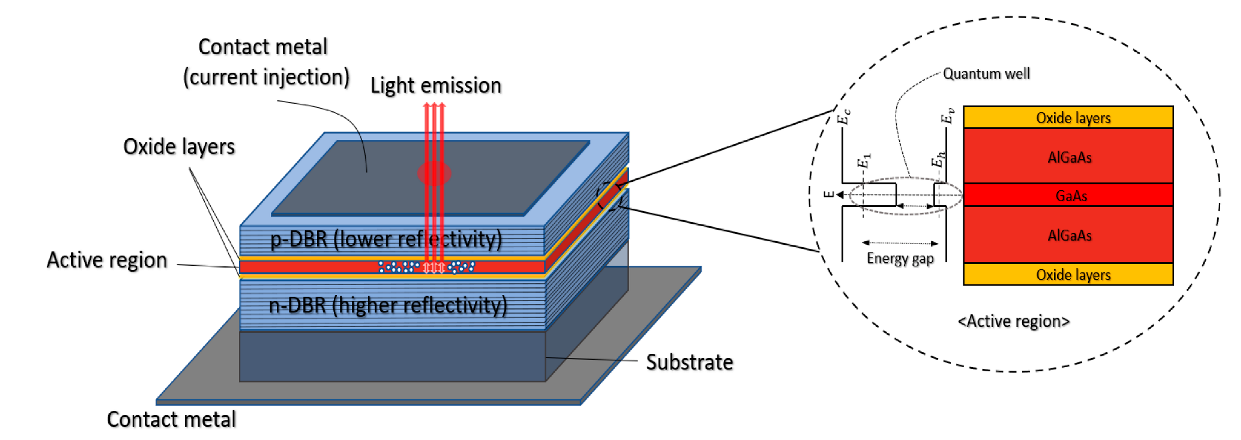



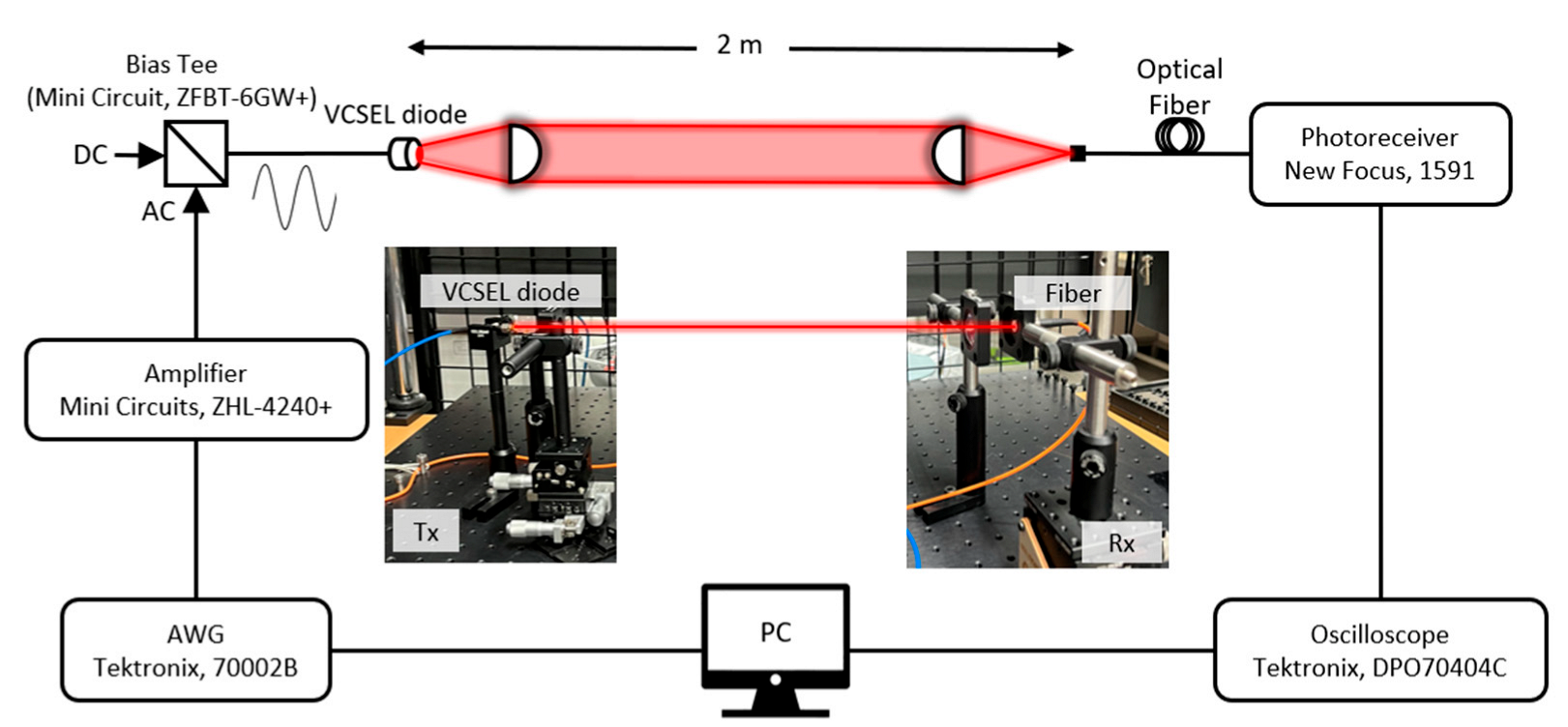

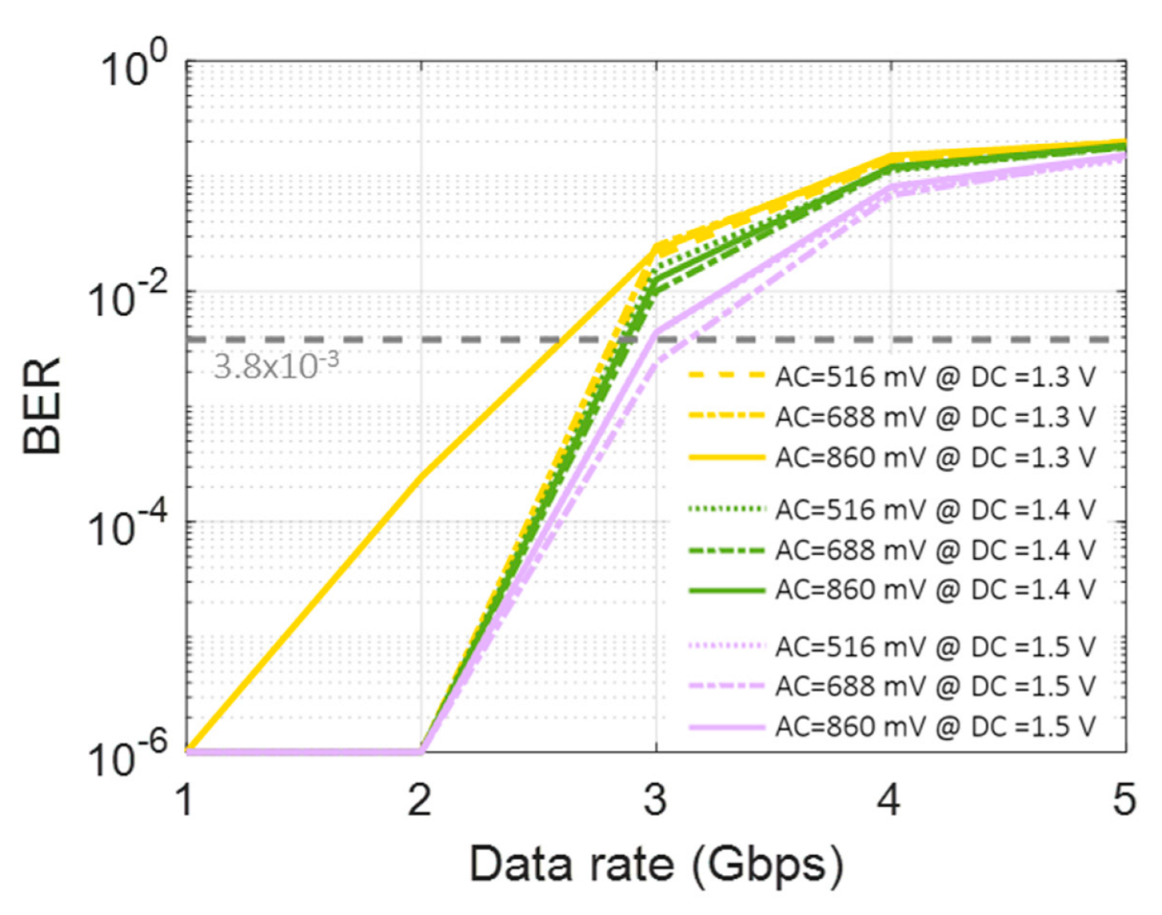
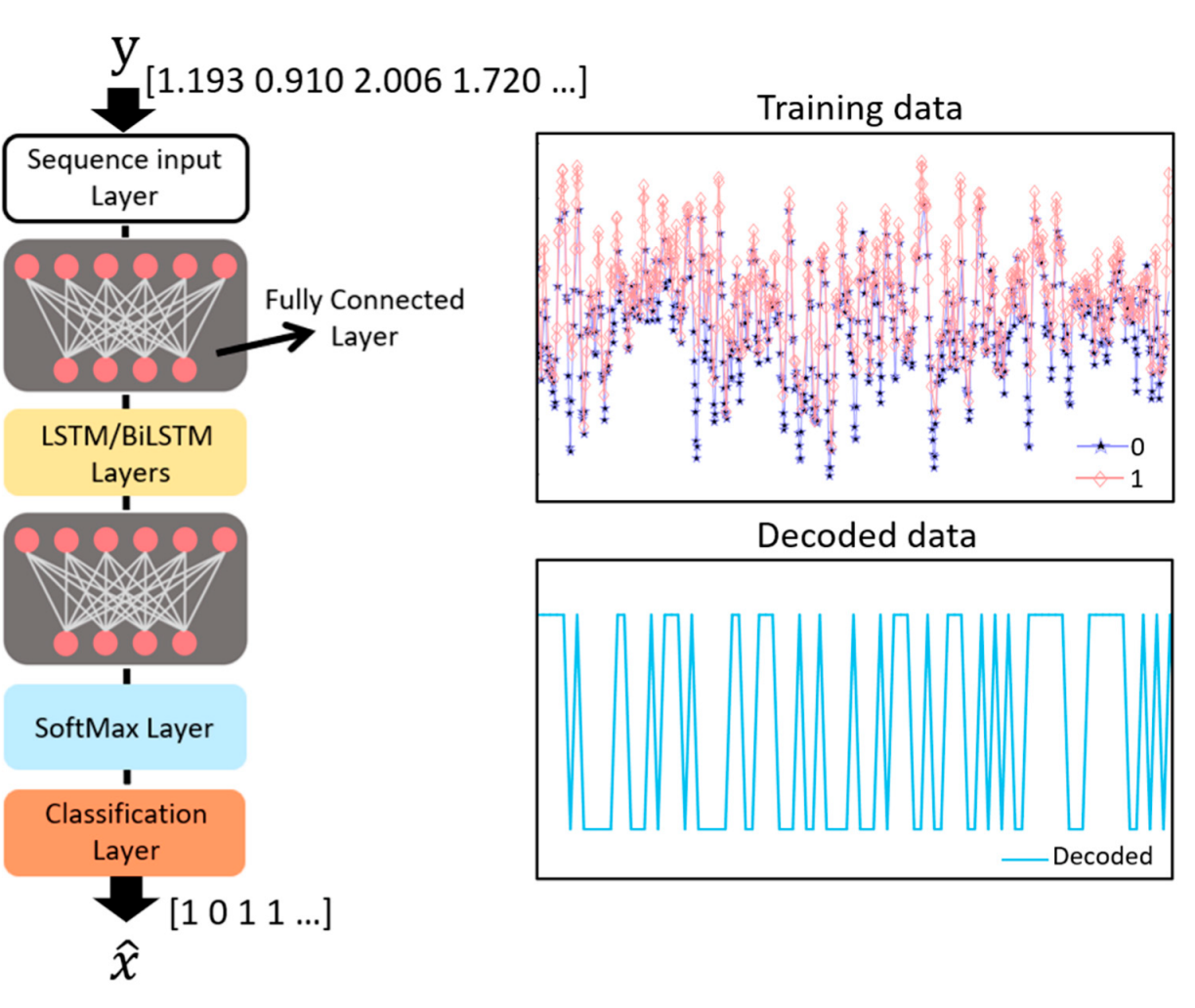

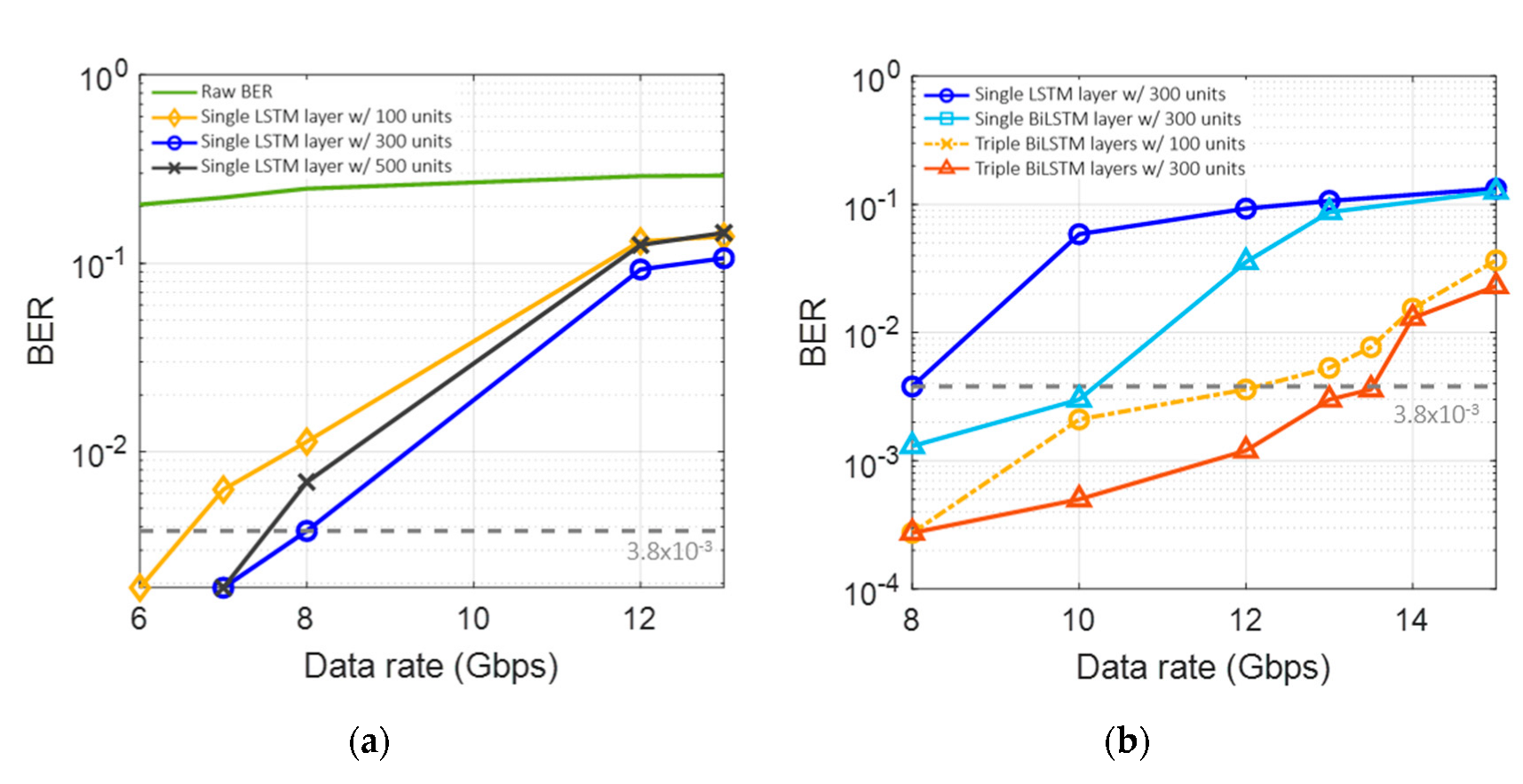
| Parameter | Values |
|---|---|
| Optimizer | Adam |
| Learning Rate | 0.001 |
| Number of Epochs | 200 |
| Gradient Threshold | 1 |
| Shuffle | Once |
| Execution Environment | GPU |
| Sequence Length | Longest |
| Loss Function | Cross-entropy |
Publisher’s Note: MDPI stays neutral with regard to jurisdictional claims in published maps and institutional affiliations. |
© 2022 by the authors. Licensee MDPI, Basel, Switzerland. This article is an open access article distributed under the terms and conditions of the Creative Commons Attribution (CC BY) license (https://creativecommons.org/licenses/by/4.0/).
Share and Cite
Oh, S.; Yu, M.; Cho, S.; Noh, S.; Chun, H. Bi-LSTM-Augmented Deep Neural Network for Multi-Gbps VCSEL-Based Visible Light Communication Link. Sensors 2022, 22, 4145. https://doi.org/10.3390/s22114145
Oh S, Yu M, Cho S, Noh S, Chun H. Bi-LSTM-Augmented Deep Neural Network for Multi-Gbps VCSEL-Based Visible Light Communication Link. Sensors. 2022; 22(11):4145. https://doi.org/10.3390/s22114145
Chicago/Turabian StyleOh, Seoyeon, Minseok Yu, Seonghyeon Cho, Song Noh, and Hyunchae Chun. 2022. "Bi-LSTM-Augmented Deep Neural Network for Multi-Gbps VCSEL-Based Visible Light Communication Link" Sensors 22, no. 11: 4145. https://doi.org/10.3390/s22114145
APA StyleOh, S., Yu, M., Cho, S., Noh, S., & Chun, H. (2022). Bi-LSTM-Augmented Deep Neural Network for Multi-Gbps VCSEL-Based Visible Light Communication Link. Sensors, 22(11), 4145. https://doi.org/10.3390/s22114145






